Aqueducts on Roman coins
| HOME |
| HOME | More literature on more aqueducts | Last modified: November, 2017 |
A) Coins from Rome
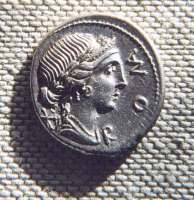 |
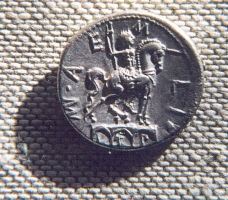 |
| Coin: private collection | |
| Number | wds 1 |
| Cointype | Denarius (AR) |
| Moneyer | M. Aemilius Lepidus |
| Timespan | 114/113 bc |
| Obverse | Female head + ROMA )1 |
| Reverse | Equestrian statue + substructure with 3 arcs + MN )2 • AEMILI • LEP |
| In honour of | M. Aemilius Lepidus & Q. Marcius Rex |
| Aqueduct | Aqua Marcia ? |
| Literature | Fuchs p10; Kek p269; Syd.554; Kowalewski2013,8 |
| )1 M and A in ligatur; )2 M and N in ligatur |
The images on this denarius have caused much discussion among scholars. The obverse side reads ROM[A] and represents the head of a female referring
to Roma or Venus behind the neck a star with six rays, the value sign for a denarius. On the reverse side an equestrian statue is shown on a plateau supported by three arches isolated from its environment together with the capitals M[MANIVS]. AEMILI. LEP, the name of the moneyer.
In 1945 M. Stuart - after elaborate research - came to the conclusion that this image was related to the aqueduct Aqua Marcia, the third aqueduct of Rome.
According to Livius the construction of a new aqueduct was started in 179 bc under supervision of the censors M. Aemilius Lepidus and M. Fulvius Nobilior.
However, M. Licinius Crassus refused any support and did not allow the aqueduct to cross his property. In the years after this event religious objections
were raised against the idea to extend the aqueduct trace to the Capitolinus.
In the year 144 bc and with the help of a different M. Aemilius Lepidus (Porcina) urban praetor Q. Marcius Rex received the order of the Senate
to restore the Aqua Appia and the Aqua Anio (Vetus) and to (re)build and finish the third aqueduct. In 140 bc new objections were raised for aqueduct water to reach the Capitolinus without success: in the same year this new aqueduct - in later days called Aqua Marcia - was put into use.
This interpretation also makes clear the relative short time of construction (seemingly between 144 - 140 bc) of an aqueduct of 92 km in length including 10 km on arcades.
Although the aqueduct was named Aqua Marcia, in 114/113 bc the moneyer M. Aemilius Lepidus may have intent to commemorate the name of one of the
original builders of the year 179 bc M. Aemilius Lepidus. The equestrian statue on the reverse side will have been - according to Stuart - M. Aemilius
Lepidus on an unfinished aqueduct.
However, the arguments of this author were rejected by M.G. Morgan who concluded that the aqueduct line of 179 bc was never built. G. Fuchs presents different interpretations of the arches under the statue: triumphal arches, arches of the Pons Aemilia bridge or a standard substruction. In numismatic circles
the image is mostly described as "Equestrian statue standing right on triumphal arch".
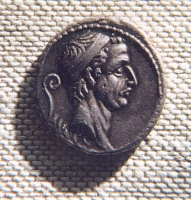 |
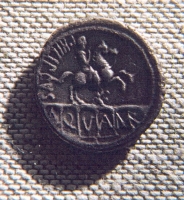 |
| Coin: private collection | |
| Number | wds 2 |
| Cointype | Denarius (AR) |
| Moneyer | L. Marcius Philippus |
| Timespan | 56 bc |
| Obverse | Male head + lituus + ANCVS |
| Reverse | Statue + arcs + PHILIPPVS + AQVA MAR )1 |
| In honour of | Q. Marcius Rex |
| Aqueduct | Aqua Marcia |
| Literature | Hill p69; Kek p267; Tameanko p92; Syd. 919; Kowalewski2013,9 |
| )1MAR in ligatur |
It was 60 years later - about 56 bc - that moneyer L. Marcius Philippus honored Q. Marcius Rex with a coin bearing the image of 'his' aqueduct,
the Aqua Marcia. This denarius is on the obverse side decorated by a bust of Ancus Marcius, behind Lituus augurum, the letters ANCVS,
apparently referring to the mythical ancestor Ancus Marcius - the fourth king of Rome.
The reverse side shows an equestrian statue based on five arches reaching to the rim and the name of the moneyer PHILIPPVS. Within the arches one reads
AQVA MR (Aqua Marcia). One assumes that here the builder Q Marcius Rex is represented together with the aqueduct which is named after him.
Note that the moneyer also belongs to the Marcia family.
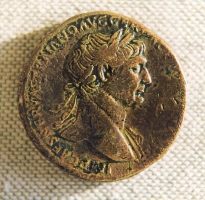 |
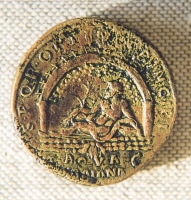 |
| Coin: private collection | |
| Number | wds 3 |
| Cointype | Sestertius (AE) |
| Moneyer | Anonymus |
| Timespan | 103 - 112 ad |
| Obverse | Traianus |
| Reverse | Genius + attributes + AQUA TRAIANA + SC + SPQR OPTIMO PRINCIPI |
| In honour of | Traianus |
| Aqueduct | Aqua Traiana |
| Literature | Hill p106; Kek p275; Price p46; Tameanko p92; Kowalewski1992, Kowalewski2013,19-21; RIC 463 |
| Note: | For the cointype Dupondius, see RIC 464; Kowalewski2013,17 |
The sestertius coin #3 reading IMP CAES NERVAE TRAIANO AVG GER DAC P M TR P COS V PP in capitals representing the bust of emperor Traian (98 - 117 AD) looking to the right. During his reign both the aqueduct Aqua Traiana and the Baths of Traian were put into use. The Aqua Traiana was built in the years 109 - 117 AD, its length was 59 km, its water came from the present Lago Bracciano, north of Rome. This specimen was coined between 103 - 112 ad (Cos V).
The text on the reverse reads SPQR OPTIMO PRINCIPI AQVA TRAIANA S C with an image that can be interpreted in different ways: the genius of the aqueduct, an image of the castellum aquae (the water distribution station) at the end of this Roman aqueduct, or a collection of general elements of the water supply of Rome.
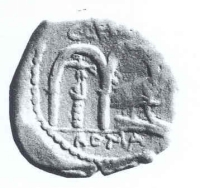 |
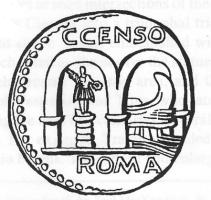 |
| Coin: Hill pag 99 fig 189 | Coin: Tameanko pag 90 |
| Number | wds 4 |
| Cointype | As (AE) |
| Moneyer | Gaius Marcius Censorius |
| Timespan | 88 bc |
| Obverse | two heads side-faced |
| Reverse | double arch + statue on spiral column + ship's prow + CCENSO + ROMA |
| In honour of | ?? |
| Aqueduct | Aqua Marcia |
| Literature | Hill p99, Kek p267, Tameanko p90, Fuchs T2 nr 14 |
This as is the first coin representing an aqueduct, the Aqua Marcia which was completed in 140 bc by Q Marcius Rex.
On the obverse of this Republican as of the moneyer Gaius Marcius Censorius, the side-faced heads of Numa Pompilius and Ancus Marcius are presented. On the reverse side in a very simplified manner, two arches of the Aqua Marcia with under the left arch on a spiral column the statue of Victoria and under the right one a prow of a warship a a trophy to commemorate a victory at see. The engraving is very crude with little attempt to realism.
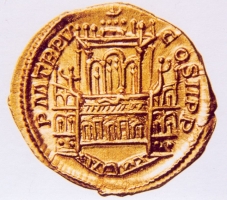 |
|
| Coin: NAC AG, A11,1998 nr 492 | |
| NAC AG: Numismatica Ars Classica AG | |
| Number | wds 5 |
| Cointype | Aureus (AV), denarius (AR), as (AE) |
| Moneyer | Anonymus |
| Timespan | 226 ad |
| Obverse | bust of Alexander Severus + IMP C M AVR SEV ALEXAND AVG |
| Reverse | Nymphaeum (Alexandri) + P M TR P V COS II P P |
| In honour of | Alexander Severus |
| Aqueduct | Aqua Julia or Aqua Anio Novus |
| Literature | Hill p98; Kek p278; Tameanko p93; RIC58; Kowalewski2013, 30 |
A rare aureus of Alexander Severus - also struck as denarius and as - from 226 ad showing the nymphaeum of this caesar, a building of which both sides are seen in perspective. In the centre, three arches, the cental arch containg two statues, the side arches one statue. On the roof facing a quadriga with left and right three pieces of statuary.
Below an open space with five arches alternately large and small. On either side of that space, the wings of the building in three tiers, in each wing, top and centre tiers of two arches, each containing a statue. Bottom tier is ornamented with a row of dots representing water-sprouts, each wing is surmounted by a standing figure. A semicircular basin in the front; in the middle - below the three arches - the genius of the Aqua Alexandrina, the last of the 11 aqueducts of Rome
This nymphaeum is an ornamental fountain including a castellum (water distribution station) which was fed by a branch of the Aqua Julia aqueduct (or the Aqua Anio Novus - but surely not of the Aqua Alexandrina !). Remains of the branch aqueduct can still be seen in the Via Pepe, close to the railway station Termini in Rome. Major parts of the nymphaeum are present in the park of the Piazza Vittorio Emanuele II (see this website under Roma -> Aqua Anio Novus). This fountain is often misnamed as "Trophies of Marius". It is the only remaining example in Rome of a class of fountains which is called 'munera' by Frontinus because of its double function (ornamental fountain and water distribution station). The coins may have been mint when the Aqua Alexandrina was put into use.
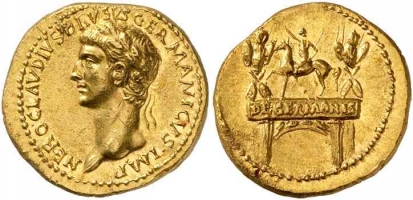 |
|
| Coin: www.wildwinds.com | |
| Number | wds 6 |
| Cointype | Aureus (AV) |
| Moneyer | Anonymus |
| Timespan | 46 ad |
| Obverse | Bust of Nero Claudius Drusus + NERO CLAVDIVS DRVSVS GERMANICVS IMP |
| Reverse | Triumphal arch [I]+ DE GERMANIS |
| In honour of | Claudius' victory over Germania |
| Aqueduct | Aqua Virgo ? |
| Literature | Hill p50; Kek p280; Kampmann 6.2; RIC 72 |
To commemorate the victories of his generals in Germany, Claudius converted one of the arches of an aqueduct, the Aqua Virgo in regio VII, into a monumental triumphal arch. The remains of the Aqua Virgo are still to be seen in the courtyard of nr. 14 Via Nazarene near the Trevi fountain in Rome. This monument is represented as a wide, single spanned arch with two Ionic columns and decorated spandrels, surmounted by an equestrian statue between two trophies. There are slight variations in the statue (Hill1989).
Note: not all numismatists are convinced that the above is a correct interpretation.
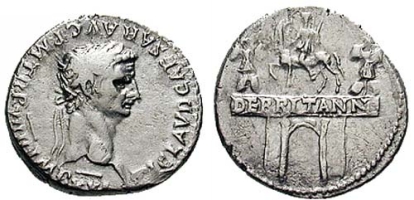 |
|
| Coin: www.wildwinds.com | |
| Number | wds 7 |
| Cointype | Aureus (AV) |
| Moneyer | Anonymus |
| Timespan | 51/52 ad |
| Obverse | Bust of Claudius looking right + TI CLAVD CAESAR AVG P M TR P VIIII IMP XVI |
| Reverse | Triumphal arch [II] + DE BRITANN |
| In honour of | Claudius' victory over Brittannia |
| Aqueduct | Aqua Virgo ? |
| Literature | Hill p51; Kek p281; Kampmann 12.3; RIC 45 |
To commemorate the victories of his generals in Germany, Claudius converted one of the arches of an aqueduct, the Aqua Virgo in regio VII, into a monumental triumphal arch. The remains of the Aqua Virgo are still to be seen in the courtyard of nr. 14 Via Nazarene near the Trevi fountain in Rome.
In 51 or 52 another arch of the Aqua Virgo was converted into a triumphal arch to celebrate the victories in Britain. It is also situated in regio VII at the point were the aqueduct crossed the Via Flaminia, the main road to the north. There are three emissions of this type: TR P VI IMP X and TR P VI IMP XI (both from 46 ad and TR P VIIII IMP XVI from 49 ad) (Hill1989).
Note: not all numismatists are convinced that the above is a correct interpretation.
B) Coins from other towns in the Roman Empire
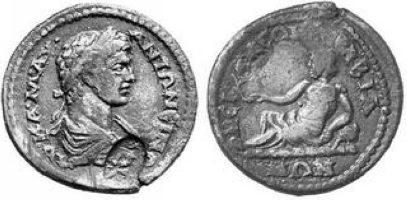 |
|
| Coin: private collection | |
| Number | wds 8 |
| Cointype | As (AE) |
| Moneyer | anonymous from Neikeia Kilbianon |
| Timespan | 211 - 217 ad |
| Obverse | Bust of Antoninus (Caracalla) + ΑΥ•ΚΑ•Μ•ΑV•ΑΝΤΩΝΕΙΝΟ |
| Reverse | river god Kilbos on pipes + ΝΕΙΚΑΕΩΝ ΚΙΛΒΙΑΝΩΝ |
| In honour of | Caracalla |
| Aqueduct | aqueduct to Neikeia Kilbianon (65 km ENE of Ephesos) |
| Literature | Kowalewski2006,7+fig 14; Kowalewski2013, 35 |
This as shows the water source - the water-jug under the left arm of the rivergod Kilbos - in combination with a waterpipe beneath the god. This technical representation is the starting point of the aqueduct to the town of Neikeia Kilbanion (present Türkönü, 65 km ENE of Ephesus, Turkey). Neikaia is not yet fully excavated. The coin was first published in the Sylloge Nummorum Graecorum v.Aulock 2993 but misinterpreted. One did not recognize that there is a pipeline beneath the rivergod. Normally on coins the rivergod lies on a 'bed' i.e. waterwaves. The obverse shows a bust of Antoninus (Caracalla) 198 - 217 ad with countermark (asklepios).
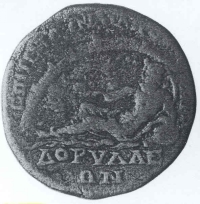 |
| Coin: Price&Trell1977 pag46 fig 78 |
| Number | wds 9 |
| Cointype | AE |
| Moneyer | anonymous from Dorylaeum |
| Timespan | 222 - 235 ad |
| Obverse | Alexander Severus |
| Reverse | genius like wds 3 + ...ΔΟΡΥΛΑΕΩΝ |
| In honour of | ?? |
| Aqueduct | Aqueduct of Dorylaeum (Phrygia) |
| Literature | Price&Trell p47 |
The aqueduct is depicted above the reclining river god. Alexander Severus was caesar from 222 - 235 ad.
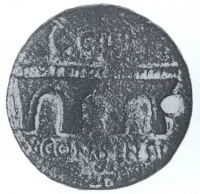 |
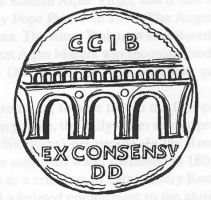 |
| Coin: Price&Trell pag 46 fig 80 | Coin: Tameanko1999 |
| Number | wds 10 |
| Cointype | AE |
| Moneyer | anonymous from Buthrotum (Epirus) |
| Timespan | 54 - 68 ad |
| Obverse | Nero |
| Reverse | Aqueduct bridge + CCIB + EX CONSENSV DD |
| In honour of | ?? |
| Aqueduct | Aqueduct of Buthrotum (Phrygia) |
| Literature | Price p47, Tameanko p94 |
Some of the provincial cities struck their own coins some of which proudly pictured their own aqueducts. The city of Buthrotum in Epirus - present day Albania - struck a series of aqueduct coins from the times of Augustus to the emperor Nero which showed an impressive two tiered, arched arcuatio. These coins were originally attributed to Babba, a city in Mauretania, North Africa, because large quantities of them were found in that location, but numismatists now believe that the mint at Buthrotum produced them (Tameanko1999).
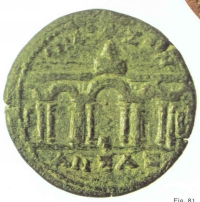 |
|
| Coin: Price&Trell pag 46 fig 81 | |
| Number | wds 11 |
| Cointype | AE |
| Moneyer | anonymous from Anazarbos (Cilicia) |
| Timespan | 222 - 235 ad |
| Obverse | Alexander Severus |
| Reverse | Structure with arches and columns + ΓB + ENΔO... + AN + AZ)1 + rivergod between AN and AZ |
| In honour of | Alexander Severus |
| Aqueduct | Aqueduct of Anazarbos |
| Literature | Price p47, Tameanko p94, Ziegler p21 |
| )1 Z in reverse |
A beautiful depiction of an aqueduct can be seen on coins of the city of Anazarbus in Cilicia, present day southern Turkey. This coin, struck during the reign of Alexander Severus 222 - 235 ad, shows an ornamented arcuratio with three triangular roofed structures above. These may be shrines decorating the arches and concerting them into a triumphal monument. Or they may be a representation of a castellum building acting as a sluice gate or distribution tank (??? wds) for the water (Tameanko1999).
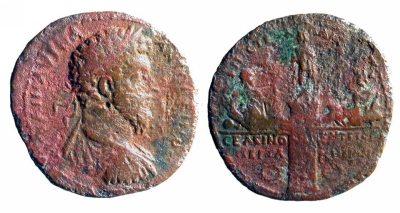 |
|
| Coin: RPC online | |
| Number | wds 12 |
| Cointype | AE |
| Moneyer | Anonymus |
| Timespan | 161 - 180 ad |
| Obverse | bust of M. Aurelius + text (see below) |
| Reverse | Statue of Asclepios + 2 rivergods (see below) |
| In honour of | the inauguration of the Madradag aqueduct |
| Aqueduct | The Madradag aqueduct of Pergamon (Turkey) |
| Literature | Kek p283ff, Jones p115 |
| "[Obverse:] [AYT KAI M] AYPHΛI left, ANTΩ[NEINOΣ] right. Bust of M. Aurelius bearded, with laurel-crown, breastplate and cloak facing right. Reverse: above EΠI ΣTP T KΛ APIΣTEOY; in exergue, ΣEΛEINOYΣ KHTEIOΣ ΠEPΓAMENΩN; B NEOKOPΩN on the base of the statue of Asclepios standing. On either side of this image are the river-gods reclining opposite each other, the Selinus with beard facing right, with cornucopia in his right arm, which rests on a gushing urn, and with leafy branch in his left hand, and the Ceteios beardless facing left, with the branch in his hand and his left hand with cornucopia on the urn. In the exergue two crowns, one on each side of the pedestal". F. Imhoof-Blumer as cited by Ch.P. Jones. |
This richly decorated coin stems from Pergamon with the bust of Marcus Aurelius on the obverse and Asclepios - often used as the representation of the town of Pergamon - with two river gods at both sides representing the rivers Selinus and Ceteios, on the reverse.
Kek is referring to the interpretation of H. Hepding (1933) later adopted by Ch.P. Jones (1991) linking the panegyric (laudatory speech) of Aelius Aristides 'on the water in Pergamon' to the completion of one of the aqueducts of Pergamon in about 178 AD - the Madradag system. The main element is the word 'water' υδωρ which in more than one occasion also was related to an aqueduct. If this interpretation is correct the panegyric was written because of the inauguration of the Madradag aqueduct.
The coin from Pergamon could also have been minted because of the same occasion: inauguration of the aqueduct; both river gods accompanying Asclepios represent the boundaries where in between the aqueduct got its place.
As Jones states: "Aelius Aristides' fragmentary 'Panegyric on the Water in Pergamon' refers to an aqueduct, not to a spring: the archaeological evidence strongly favours the Roman Madradag-aqueduct as the one in question, which must have been inaugurated by a solemn festival in the reign of Marcus Aurelius; coin-types of Pergamon struck under that emperor show the rivers Selinus and Ceteios, and may have been issued on this occasion to glorify the city's abundance of rivers".
This explanation is a supposition and archaeologically not confirmed.
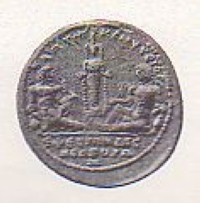 |
| Coin: FiE vol 1 (1906) pag 49+65 |
| Number | wds 13 |
| Cointype | AE |
| Moneyer | Anonymus |
| Timespan | 138 - 161 ad |
| Obverse | Bust of Antoninus Pius + text (see below) |
| Reverse | Statue of Artemis + river gods Kaistros and Kenchreios (see below) |
| In honour of | The abundance of (aqueduct) water to Ephesos (?) |
| Aqueduct | An aqueduct of Ephesos (?) |
| Literature | Kek p285ff, Jones p115 |
| "[Obverse:] T AIΛIOΣ KAIΣAP ANTΩNNENOΣ (sic). Bust of Pius with laurel-wreath, breastplate and cloak facing right. Reverse: EΦEΣIΩN ΔIΣ NEΩKOPΩN in exergue, KAYΣTPOΣ left and KENXPEIOΣ right above. The cult image of Artemis Ephesia, frontal, on a pedestal, between the two beardless river-gods Cayster and Cenchreios reclining opposite each other, each holding reed on shoulder and with the other arm on a gushing urn" F. Imhoof-Blumer as cited by Ch.P. Jones. |
This coin from Ephesos is almost a pendant of the coin above from Pergamon. The reserve shows a statue of Artemis Ephesia with on both sides two river gods: Kenchreios facing to the left and Cayser facing to the right. In this case J. Keil (1922-24) made the statement that both river gods not only represent rivers but also an aqueduct, not unlike a coin with a spring nymph with a bowl out of which she poors water into a vessel representing the new water source for an aqueduct in the Marnas valley (see Kek's note 108 referring to Keil p 117 ff).
Keil did some research which river was meant by the Kenchreios and in his opinion it was the present Degirmen Çay, 3 - 4 km south of Kusadasi.
New finds underline the assumpion that the aqueduct in between the Kenchreios and the Kaistros could have been one of the Ephesos' aqueducts often called Aqua Julia which new source also could have been the reason to mint this new coin.
"We may assume that under Antoninus Pius an important improvement or enhancement of this aqueduct had taken place, giving the moneyer reason to represent the Kenchreios, which made its water available to the city in such great abundance, as a counterpart of the Kaistros", as Jones states. In addition to the summarizing remarks he made on Pergamon (see above) he continues: "The same coins are a ripost to a type struck by Ephesos under Antoninus Pius, which celebrates the Kaistros and the Kenchreios, both of which supplied aqueducts of Pergamon's great rival".
This explanation is a supposition and archaeologically not confirmed.
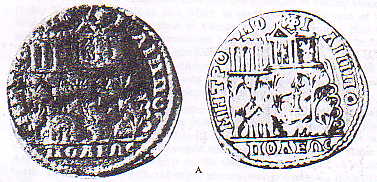 |
| Two versions of the reverse of the same coin-type. Coin: Biernacka1973b |
| Number | wds 14 |
| Cointype | AE |
| Moneyer | Anonymous |
| Timespan | 211 - 217 ad |
| Obverse | Laureate bust of Caracalla + AVT K M AVPH - ANTΩNEINOC |
| Reverse | Hill (see desription below) + MHTPO - MO - ΦI - ΛIΠΠO - ΠOΛEΩC |
| In honour of | Caracalla |
| Aqueduct | Aqueduct of Plovdiv (Philippopolis)(Bulgaria) |
| Literature | Biernacka1973b, Howgego2005 |
"On the reserse side of this coin, there is a picture of a forest-grown hill. On the top on the right side, there is a temple topped with a tympanum, adorned with a shield and spear. The facade of the temple has four columns. In the center, between the columns, there is a statue of Apollo, holding in his left hand a bow and in the right an epergne. On the right hand side of the temple, there is a statue of a man on horseback on a high pedestal. To the left of the temple, at a slightly lower level, there is an other building with a low roof and facade with four columns. At the foot of the hill, to the left, there is a temple with a tympanum, also with four columns in its facade. On a rock in the center of the hill, there is a column on which there is a statue of Apollo with bow and epergne.
At the bottom, at the right edge of the coin, there is - as in the coin of Antoninus Pius (see below wds15) - an arcade of four arches, which represents an aqueduct. ... it is shown in a very schematic and awkward way". "...the hill can be identified with Dzendem Tepe (see map) ... with the temple of Apollo Kendrisos...the remains of an aqueduct have been found running towards the neighbouring hill which must have been the Bunardzik". (from Biernacka1973b pag 326/7)
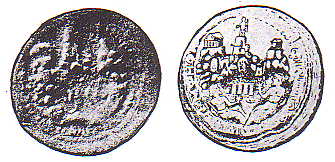 |
| Two versions of the reverse of the same coin-type. Coin: Biernacka1973b |
| Number | wds 15 |
| Cointype | AE |
| Moneyer | anonymous |
| Timespan | 138 - 161 ad |
| Obverse | Antoninus Pius |
| Reverse | The acropolis of Philippopolis on three hills |
| In honour of | Antoninus Pius |
| Aqueduct | Two conduits of the aqueduct of Philippopolis |
| Literature | Biernacka1973b |
This coin from the town of Philippopolis (present Plovdiv, Bulgaria) depicts the acropolis on three hills with below the arcades of an aqueduct and the personifications of two water pipes running along it from the springs in Rodop (present the localities of Kuklen and Markovo).
As Biernacka states: "The coin shows a panorama of Trimontium, that is an acropolis located on three hills. On top of the central hill, considered to be the hill today known as Dzambas Tepe, there is a statue of Apollo, and on the two hills on either side (on the left Taksim Tepe and on the right Nebet Tepe, see map) there are temples. At the bottom of the picture there are two half reclining male figures facing each other, which in the opinion of some researchers personify the river Marica (ancient Hebros) and its left tributary Piasacnik or perhaps the Rodop".
"In the background, that is behind the half reclining male figures, there are four arches under the central hill..." supposed to represent an aqueduct, and not the stadium nearby as was suggested by an other author because of a different kind of representation of stadia on other coins.
Based on the statement that the situation of buildings and their location in relation to each other here was quite faithfully and exactly reproduced on the coin, mrs Biernacka comes to the conclusion that "... it can be assumed in all probability that the picture on the coin in question shows the panorama of the three hills most characteristic of the city [Philippopolis] and the outline of the aqueduct running in their direction, along which water was brought by two different pipes from springs arising in Rodop, which are personified by the two half reclining beared male figures." Fieldwork and excavations prove "... that Philippopolis was supplied with water by two conduits, the intakes of which were from the Karstic springs rising in places known today as Kuklen and Markovo. These two brick-built conduits ran together over a one-storey aqueduct over the last six muddy kilometres to the town". (Biernacka 1973b)
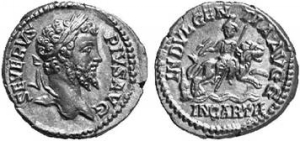 |
|
| Coin: Ancient Peddler | |
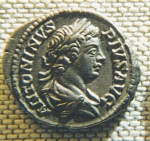 |
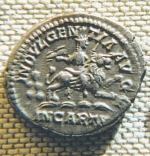 |
| Coin: privat collection | |
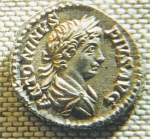 |
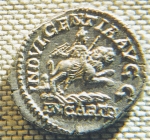 |
| Coin: privat collection | |
| Number | wds 16 |
| Cointype | Denarius (AR) |
| Moneyer | Anonymus |
| Timespan | 204 ad |
| Obverse | SEVERVS PIVS AVG (and ANTONINVS PIVS AVG) - Laureate head right |
| Reverse | INDVLGENTIA AVGG - Dea Caelestis riding right on lion, leaping over water gushing from rock. In exergue: IN CARTH |
| In honour of | Septimius Severus (and his son Caracalla / Antoninus Pius) |
| Aqueduct | Aqueduct of Carthago |
| Literature | RIC 266; RSC 222 (and RIC103a; RSC97; BMC280); Kowalewski2013,23 |
When Septimius with his imperial family took their tour of Rome's African possessions, most notably Carthage and Lepcis, in addition to many works of beautification, he also built a new aqueduct in Carthage and improved, with perhaps another, the water supply in Lepcis. This coin and another with the same motiv but issued by his son Caracalla (Antoninus Pius), commemorates Septimius (and his son) the indulgent benefactor, showing Dea Caelestis riding a lion holding a thunderbolt and scepter which leaps over water cascading from the aqueduct.
The goddess Dea Caelestis, favorite deity of the Carthaginians, is rarely represented on coins. The lion tamed by her became a symbol of Africa.
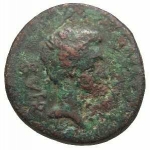 |
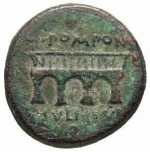 |
| Coin: Münzkabinett, Staatliche Museen zu Berlin SPK | |
| Number | wds 17 |
| Cointype | Bronze (AE) |
| Moneyer | Anonymus |
| Timespan | 27 bc - 14 ad |
| Obverse | BVTHR - AV[GVSTVS] - THR in ligatur |
| Reverse | T POMPON // C IVLI II VIR / Q |
| In honour of | Caesar Augustus |
| Aqueduct | Aqueduct of Buthroton |
| Literature | RPC I Nr. 1381,1 Taf 70 |
Buthroton (present Butrint in Albania) was founded as Colonia Iulia Buthrotum by L. Plotius Plancus. The reverse memorates the magistrates' responsibility for the issueing.
Almost immediately after ceasar Augustus' victory the coinage of Butrint changed to reflect its new loyalties; as well as including Augustus' portrait, the city's name now appears as Colonia Augusta Buthrotum. For Butrint the change seems to have been easy; indeed, it may have been welcomed. The city had for long had a close relationship with the rich landholder Titus Pomponius Atticus, and Atticus' daughter had already six years previously married Augustus' friend and general, Marcus Vipsanius Agrippa. For Butrint the link with Agrippa ensured not only continuity but provided an important link to the emperor himself. Not surprisingly the city erected not one but two statues in honour of Agrippa.
The most radical changes to the urban layout of Butrint may date to the reign of Augustus. The city was furnished with an aqueduct bringing in copious amounts of water and soon fountains and bathhouses sprang up everywhere. The alignment of the aqueduct is intimately linked to the layout of the suburb on the Vrina Plain, and it is likely that the latter was designed in this period. Changes may have been planned also for the forum and sanctuary area.
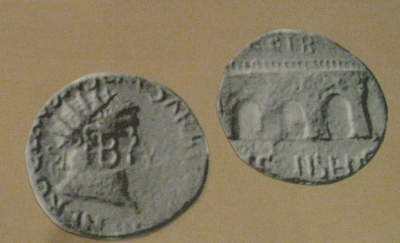 |
|
| Coin: | |
| Number | wds 18 |
| Cointype | Bronze (AE) |
| Moneyer | Anonymus |
| Timespan | 54 - 68 ad |
| Obverse | NERO CLA[VDIVS CAES AVG (GERM(A))]; B.AV countermark on neck |
| Reverse | [D EX CON]SE[(N); [CCIB] in ex |
| In honour of | Caesar Nero |
| Aqueduct | Aqueduct of Buthroton |
| Literature | RPC I Nr. 1400 or 1407; Abdy2012, fig 5 |
Production of coinage at Butrint spans about a century: from the inception of the city as a Roman colony in 44 BCE through to the reign of Nero. The coin types promote the city’s status through its mythological [sacrificial bull and sanctuary of Asklepios] and monumental concerns [aqueduct / bridge].
The visual abbreviation of the structure appears on the coins almost as a bridge with a 'railing' as opposed to, for example the famous Pont du Guard with its massive triple levels of arches which had to span a far deeper gorge. In the first place, the aqueduct [in Butrint] was a much more gracile structure than the massive bridge upon which it once stood. It had the appearance more of a 'pipe on stilts' in comparison to the Pont du Gard's bulk.
From: Abdy 2012, in which also two other interesting coins, depicting the aqueduct / bridge, are presented: a Claudian and another Nerorian bronze.
Literature
R. Abdy (2012): Monuments, myth and small change in Buthrotum (Butrint) during the early empire (in: The city and the coin in the ancient and medieval world, F. Lopez-Sanchez (ed), BAR int.ser. vol 2402 (2012) pag 91-101)
T. Ashby (1935): The aqueducts of ancient Rome
G.G. Belloni (1973): Le monete di Traiano
M. Biernacka-Lubanska (1973): Iconographic sources on the history of Roman aqueducts in Northern Thrace (in: Archaeologia Polona vol XIV (1973) pag 315-329)
G. Fuchs (1969): Architekturdarstellungen auf römischen Münzen (in: DAI, Antike Münzen und Geschnittene Steine, Band 1 (1969) pag 14 ff)
M. Hainzmann (1975): Untersuchungen zur Geschichte und Verwaltung der stadtrömischen Wasserleitungen
H. Hepding (1933): ΠOΥΦINION AΛΣOΣ (in: Philologus vol 88 (1933) p99ff)
P.V. Hill (1989): The monuments of ancient Rome as cointypes
Ch.P. Jones (1991): Aelius Aristides 'On the Water in Pergamon' (in: AA 1991, p111ff)
U. Kampmann (2004): Die Münzen der römischen Kaiserzeit
S. Karwiese (2006): ΠOΛIΣΠOTAMΩN, stadt der Flüsse (in: Wiplinger2006)
J. Keil (1922-1924): Ortygia, die Geburtsstätte der ephesischen Artemis (in: OJH vol 21/22 (1922-1924) pag 113 ff)
D. Kek (1974): Der römische Aquädukt als Bautypus und Repräsentationsachitektur
P. Kowalewski (1992): Symbole des Wassers und Bauten der Wasserversorgung in Darstellungen auf Münzen und Medaillen der Antike (in: Mitteilungen des Leichtweiss-Institut für Wasserbau der TU Braunschweig, Vol 117 (1992) pag 229ff)
P. Kowalewski (2006): Flussgötter und ihre Attribute auf antiken Münzen (in: G. Wiplinger Cura Aquarum in Ephesus, 2006)
P. Kowalewski (2013): Bauten der Wasserversorgung und Abwasseranlagen auf antiken Munzen (DWhG Special series nr 9, 2013)
M.K. Malott: Nomine Caesaris: an examination of the propagandistic functions of the aqueducts ... (CAC-contest, on the web)
M.G. Morgan (1978): The introduction of the Aqua Marcia in Rome 144 - 140 bc (in: Philologus 122 (1978) pag 25 - 56)
M.J. Price and B.L. Trell (1977): Coins and their Cities - Architecture on the ancient coins of Greece, Rome and Palestine, pag 46 & 47
(RIC=) H. Mattingly, E.A. Sydenham ea (1923 - 1994): The Roman Imperial Coinage
M. Stuart (1945): The Denarius of M' Aemilius Lepidus and the Aqua Marcia (in: AJA vol 49-3 (1945) pag 242 ff)
M. Tameanko (1999): Monumental coins
B. Weisser (2005): Pergamum as paradigm (in: E. Howgego (ed) Coinage and Identity in the Roman Provinces (2005) pag 138 ff)
R. Ziegler (2005): Geschmückt mit römischen Tropaia (in: Jahrbuch für Numismatik and Geldgeschichte der Bay Numism Gesellschaft, Jahrgang 2003/2004 (2005) pag 15 ff)
Roman money
The ratio behind coins from Rome in the first centuries AD:The basic coins were the as and the sesterius.
The semis (1/2 as) and the quadrans (1/4 as) were made of copper. The as was also made of copper.
2 as equals 1 dupondius, made of brass.
4 (2,5)* as equals 1 sestertius, and was made of copper, abbreviated into HS)*
16 (10) as equals 4 sestertii (copper) equals 1 denarius (silver)
1 aureus (made of gold) equals 25 denarii (silver) which is 400 as (copper)
In the eastern part of the empire an other system was in use, with oboles (copper), drachms (silver) and talents (gold).
A Roman soldier in the 1st c AD earned annually 225 denarii of which 100 was subtracted because of the costs of subsistence.
)* in Republican time 2,5 as equaled 1 sestertius. That 2,5 ratio can be written as I+I+S (S from Semi =1/2) which reads as HS